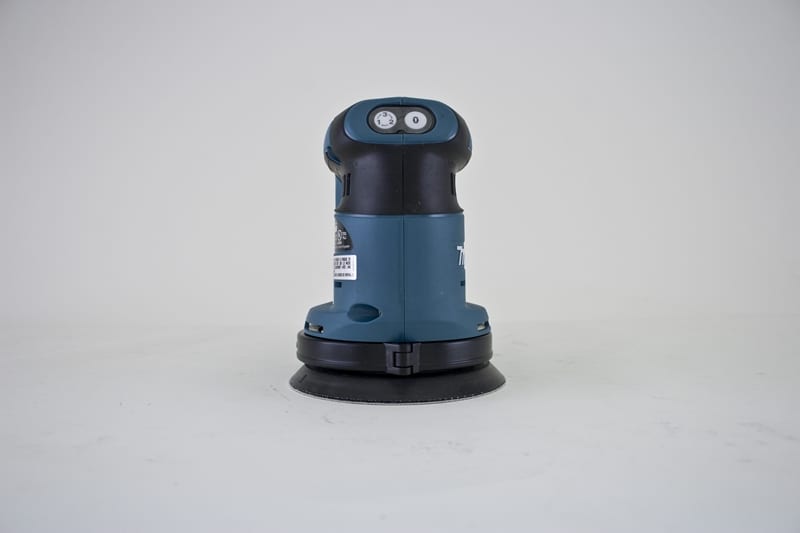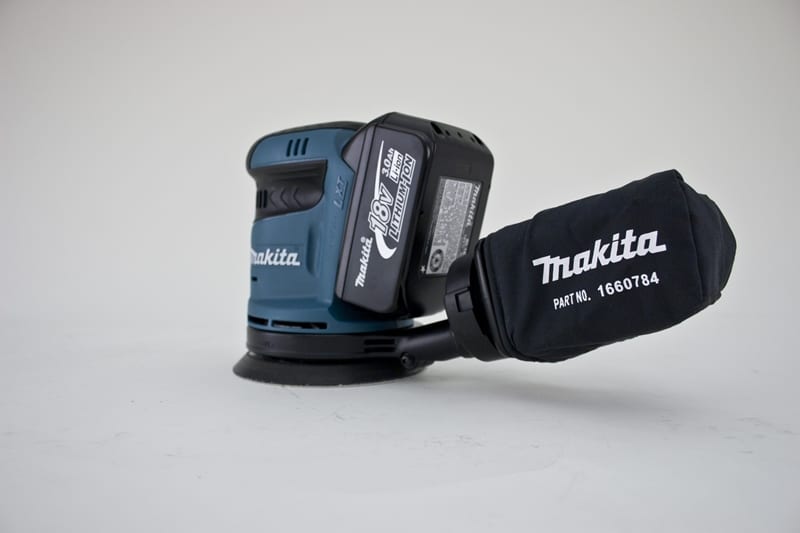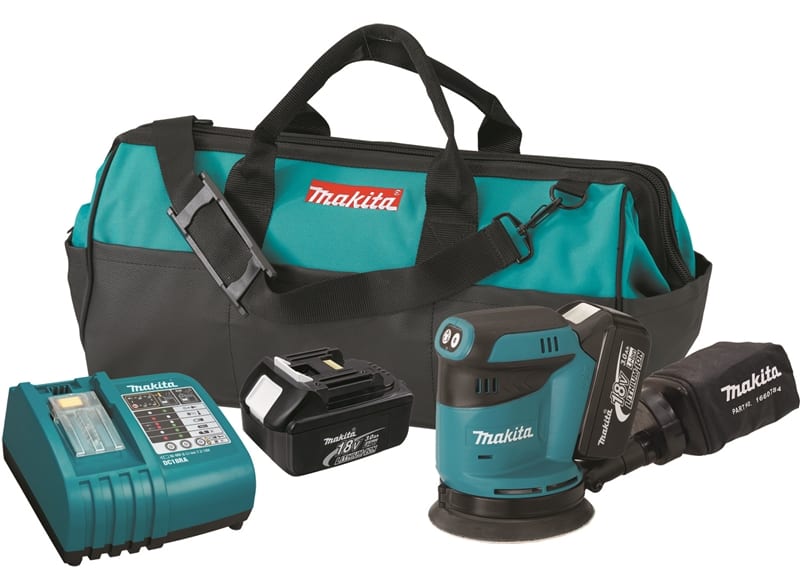I’ve got two corded orbital sanders, which is in itself a story. My Porter-Cable is about 10-12 years old. I’ve repaired and rebuilt that thing over and over again throughout the years. About 8-9 years ago I somehow misplaced it in the Jeep I drove doing trim carpentry work. In my defense, the back of the Jeep was filled with everything I could get within reach of the tailgate. Since I really needed an orbital sander, I broke down and picked up a DeWalt. Since then, I’ve easily put 150-200 hours on that tool. I eventually cleaned out the Jeep to sell it…which is when I found my missing Porter-Cable! Today, I’m still using both for most of the work I do. When I got ahold of the Makita XOB01 18V random orbit sander, I wondered how to best use this 18V tool in my carpentry work.
The Makita XOB01 orbital sander makes a lot of big claims. That includes 40 minutes of run-time in the low-speed setting. I happened to have a couple of jobs where I could test out this sander. I wanted to see if it could hold up to the work I normally reserve for my corded sanders. The first opportunity I had was on a job where I needed to shape a piece of wood to fill a 7/16″ gap on a built-in. I rough-cut a piece of poplar and was able to literally pull out the Makita and sit there on the bumper of my truck and finish it to a perfect fit. This was shaping up to be a great start.
Makita XOB01 18V Random Orbit Sander First Impressions
Using the Makita, the first thing I noticed was that it was so much quieter than my other corded orbitals. I love where they put the battery, vertically just behind the handle. You can grab it from the front or the top. In both positions, the weight seems balanced. Though it’s a little butt-heavy, it’s not awkward so that you have trouble getting it into tight spots.
I also liked how you could set it down on the table and give it a 360º spin with just the flick of a finger. It has excellent bearings and a super-smooth action that my corded sanders certainly don’t have anymore—if they ever even did. Dust collection seemed pretty good. That’s not something I run into a lot with my work, since I fab most of my pieces outside the homes I’m working in. Without a vac, and particularly if you’re using a 220 grit or finer paper as I’m apt to do in order to remove the shine off flooring repairs and such, 100% dust containment is near impossible.
Controlling the Speed
My older sanders don’t have rheostat speed control. A three-speed switch on an orbital is new to me. Some of the newer corded models have dials to control the speed. For the Makita, the speed control seems more like a battery-saving device than anything else.
I always kept mine at the fastest speed. You will, however, get more run-time if you drop it down. I’m also a fan of a straight rocker switch, but I like how the second button lets you turn off the sander. You don’t have to cycle it down with the same button. Unlike a speed dial, the Makita forgets where it was each time you start it up. If you want to use it at low speed, you have to set it each time. The pad brake actually works very well. The orbital pad stops spinning in just a few seconds after turning off the tool.
Makita XOB01 Random Orbit Sander Run-time
Battery life was pretty good. I found the Makita XOB01 18V Orbital Sander to be somewhere in the vicinity of 20-25 minutes depending on what pad I was using and how hard I was pressing down on the sander. I don’t doubt Makita’s claim that you’d get 40 minutes in low-speed mode. That doesn’t seem like a common application for a tool like this. The bottom line is that it charges in just 30 minutes. With the two 3.0 Ah batteries in the kit you could get nearly continuous run-time if needed.
With my drills, I’ve obviously switched entirely to cordless. But for sanding and such, I tend to wonder if the advantages of cordless can overcome corded orbital sanders. My first impression is probably not. When you’re on a jobsite you typically have power runs for your chop saw or table saw. Running a corded orbital sander is certainly no big deal. The second thing to note is that using the Makita XOB01 orbital sander means you’re dropping the speed down to around 80% of what you get with a corded model. It’s an apparent trade-off in order to manage the battery life of the tool. The upside is that there’s also virtually no vibration. Even when you put pressure on the tool, the Makita doesn’t get too much more in the way of vibration on the workpiece or on your hand.
No Power on the Jobsite? No Problem
Recently, I was doing some work at a mobile home rental in the north side of the city where I live, and the owner keeps the power off in-between renters. In fact, they even warehouse the AC units on these things in between leases in order to make sure nobody swings by and lifts them for scrap.
In this particular mobile home, I was touching up countertops. Having a tool like the Makita random orbit sander with some 80 grit paper would have helped me smooth out the top surface before re-applying the Formica. As it turns out, I had to use a manual rasping tool to take care of the high spots, which took a lot of elbow grease to prep the counters.

Makita XOB01 Specs
- Motor: Brushed
- Pad Size (round): 5 in.
- Orbits Per Minute (3-speed): 7,000, 9,500, 11,000 OPM
- Orbit Diameter: 1/8 in.
- Vibration: 2.5 m/s²
- Dimensions (LxWxH): 6-7/8 x 4-7/8 x 6 in.
- Net Weight (with battery): 3.6 lbs.
- Speed (max): 11,000 OPM
- Price: $329 (kit), $119 (bare tool)
What It Boils Down To
In terms of convenience, a tradesman is going to have a hard time passing up this tool. But you’re also not going to want to use it on larger jobs where you could just as easily run power and grab a corded model with a lot more power. This is particularly true when you have to run power anyway for your saw, router, or other equipment. If you’re trying to remove 1/32″ or 1/16″ on some materials or correct something that’s out of square (say you want to true something up), this is going to be a great tool for you. And obviously, if you’re prone to running into situations where getting adequate power is an issue, then the Makita can be a great tool to have in the arsenal.
You can pick up the Makita XOB01T kit with a 5Ah battery, charger, and bag for $329. The bare tool runs just $119.





